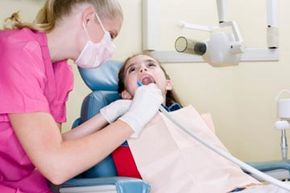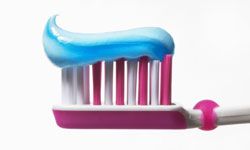You've probably noticed that fluoride is present in virtually all brands of toothpaste; as the writing on the box says, it protects against tooth decay. So why would you want a toothpaste without it? And would a dentist use it? Let's investigate.
Fluoride is the 13th most common element in the Earth's crust. It shows up naturally in some soil and water. Back in the 1940s, scientists realized fluoride prevents tooth decay, and so more was added to the public water supply in most cities, causing tooth decay rates to drop by 50 to 60 percent [source: American Dental Hygienists' Association]. Today more than 60 percent of Americans drink fluoridated tap water [source: Kids Health]. The Centers for Disease Control (CDC) considers community water fluoridation one of the 10 great public health achievements of the 20th century. Fluoride toothpaste became standard in the mid-1950s.
Advertisement
So how does fluoride work? Simple: It works with saliva to protect tooth enamel from damage by bacteria and acids that lurk in your mouth. In addition, fluoride re-mineralizes teeth, so if you have mild decay, your teeth can actually get stronger. But there's a caveat.
Too much fluoride may cause fluorosis: spotted discoloration on the teeth. Kids younger than 6 are typically at risk [source: Danoff]. Luckily, almost all fluorosis is "very mild to mild" [source: Kids Health]. But opponents of fluoride point to a CDC study that showed that 41 percent of kids aged 12 to 15 today have mild fluorosis; in 1986, the rate was 23 percent. (The Department of Health and Human Services is proposing a reduction in the level of community water fluoridation, as people are also receiving fluoride from other sources, such as toothpaste, sodas and juices, as well as dental treatments [source: DHHS])
Apart from fluorosis, the only other danger with fluoride is overdose. The lethal dose of fluoride is about 5 mg fluoride for every 2.2 lbs. (1 kilogram) of body weight. If you swallow a little, you'll be OK. But one tube of toothpaste holds enough fluoride to kill a 60-pound (30-kilogram) child if the whole tube was swallowed [source: Fluoride Action Network]. This is why children should be only given a pea-sized amount of toothpaste on their brushes and supervised so they spit out, rather than swallow, after brushing. If your child doesn't look or feel good and you suspect he swallowed a lot of toothpaste, call poison control immediately.
Fluoride allergies exist, too, but they are very rare. Only one percent of the population is hypersensitive to fluoride. They get skin rashes, headaches, weakness, joint pain, blurred vision, fatigue or canker sores when exposed to about 1 mg per liter of water [source: Fluoride Action Network]. They can recover from fluoride exposure, but should avoid it.
So, if you are concerned about too much fluoride, what should you do at the dentist?
Fluoride at the Dentist
Dentists will let you opt out of fluoride treatments, but explain why so they are aware. Note that they do not use toothpaste in cleanings. For the polishing stage, they use prophy paste, a pumice-based gel that has a minute amount of fluoride. It is so small, that an alternative is not available normally.
Some dentists are part of a fluoride-free movement and never use fluoride treatments. They simply omit this step from a regular cleaning procedure. Or they may use ingredients such as synthetic hydroxyapatite as a fluoride replacement [source: BioSafeDentistry]. To find a fluoride-free dentist, visit sites like fluoridefreedentist.com or biosafedentistry.com.
Other options for reducing your fluoride intake include drinking bottled water and using fluoride-free toothpastes. But be aware that fluoride-free toothpastes often are pricey, and they don't offer the re-mineralizing property of fluoride.
Advertisement


